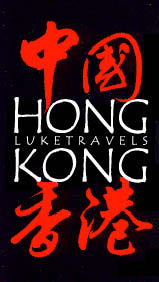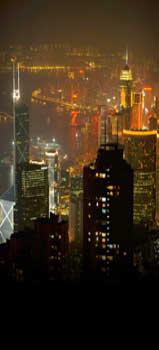| |
 Hong Kong: Unique Sights
Hong Kong: Unique Sights
Victoria, now
commonly known as Hong Kong Island, is one of the most densely
populated areas on Earth. Its business hub is Central District, on
the north side across the bay from Kowloon.
Just east of Central is Wan Chai, once famous as a sailors' playground and still a great place for dining and nightlife. At night, the area comes alive with colorful neon signs as the restaurants and nightclubs bustle with activity. You will also find Hong Kong's oldest post office and a unique police museum here. There are cultural events daily at the Arts Centre on Harbour Road and exhibitions at the Museum of Chinese Historical Relics.
Causeway Bay is to the east of Wan Chai. Known as East Point when the British first settled here in the 1840s, Causeway Bay is now full of high-rises that have taken away much of its picturesque, residential quality. The 8-hectare (19-acre) Victoria Park dominates the area, as do the
Cross-Harbour Tunnel and the Aberdeen overpass. On weekends, the Urban Services League brings performers to the park for free shows; at other times, you will see plenty of tai chi (shadow boxing), lantern and flower festivals, etc. Also of interest along the waterfront is the Causeway Bay typhoon shelter (a great place for hiring dinner sampans in summer) as well as the Royal Hong Kong Yacht Club basin. You can also see the famed Noon Day Gun, a well-known landmark once fired by Noel Coward, who mentioned it in Mad Dogs and Englishmen.
At the eastern end of the island's tram route is Shau Kei Wan, once a pirate's haunt, now a residential area and home to the colony's second largest fishing fleet. Tam Kung Temple honors the second deity of the boat people, and in May there's a festival celebrating Tam Kung's birthday. Shing Wong Temple is near the tram terminus.
Stanley, also on the south side, was a pirate hideout in the 1840s. Formerly known as Ch'ek Ch'u ("Red Pole"), this once small fishing village was named after a secretary of state for the colonies. The military cemetery is full of markers from the Japanese occupation. Tin Hau Temple represents a bit of old China here, especially during birthday celebrations in April. Otherwise, the village is known for its beachfront, its proximity to Stanley Prison, Hong Kong Sea School, busy Stanley Market, and Stanley Restaurant.
Repulse Bay, on the south side of the island, was named after the HMS Repulse, which routed pirates in the mid-19th century. Some people insist it should be called "Repulsive Bay" because of the Monday morning garbage left by the summer weekend crowds. There are great views of nearby islands and the South China Sea—despite the new high-rises that protrude everywhere—as well as historic sites. On summer weekends, the traffic is terrible.
Continuing west on the island's south side is Aberdeen, the harbor home of several thousand boat dwellers. Aberdeen was originally the main fishing and
entry port on pre-colonial Hong Kong, and in fact it was a small settlement nearby that eventually gave the entire island its name—Heung Gong, usually translated as "Fragrant Harbor."
Right next to Central to the west is the Western District, the first area settled by the British. This area has a significant amount of Chinese influence and is home to many Chinese artisans. Here you can buy everything from herbs and ginseng at roadside shops and stalls, to furniture and jewelry. Western Market is not to be missed if you're in the area. It's a classic reconstructed Edwardian building (located on the corner of Connaught Rd. and Morrison St.) that sells specialty items like fabrics. If you're interested in antiques, Hollywood Road
(Lok Ku Road) is not to be missed either. Here you can find Chinese porcelain and rosewood and
black wood furniture. Also on this road is the Man Mo Temple, one of the oldest in Hong Kong and dedicated to Kwan Kung, the god of war, and Man
Cheong, the god of literature.
 Hong Kong Regions
Hong Kong Regions
Hong Kong can be divided into three main regions—Hong Kong Island and nearby islets; the mainland Kowloon Peninsula and Stonecutters Island; and the New Territories, composed principally of a large area on the mainland, Lantau Island, and most of the colony's 235 other small islands. Part of the colony is situated in the Zhu
Jiang, or Pearl River, delta; the Sham Chun River forms the border with China.
Much of Hong Kong is hilly, and substantial areas of the low-lying terrain consist of land reclaimed from the sea. Only about 12 percent is forested, but small tropical and subtropical plants are abundant elsewhere. Hong Kong's small amount of fertile soil is concentrated in the mainland portion of the New Territories, near Deep Bay. The highest point, at 957 meters (3,140 feet), is Tai Mo Shan.
Although most tourists come to Hong Kong Island for the mind-boggling shopping and the abundance of first-rate restaurants, there are a few other things you won't want to miss.
The first is Victoria Peak. After a ten-minute ride on a tram up the 610-meter (2,000-foot) hill, you emerge at one of the most beautiful vistas in the world, a stunning sweep of ocean and city. Almost 610 meters (2,000 feet) straight up, it offers the best view in the colony. Take the historic Peak Tram (constructed in 1888) from Garden Road to the Tower terminus (HK$12 one way for adults, HK$4 for children). There are meals and snacks available at the Peak Tower at 410 meters (1,350 feet). Have a good walk around first, and watch the handicraft demonstrations at Peak Tower Village.
The second is Aberdeen, the harbor home of several hundred junks where several thousand boat dwellers live. It's a true cultural experience, full of bright colors, strange sounds, and mystifying odors.
Ocean Park makes a splendid excursion for both children and adults. It's much more than an oceanarium—it features amusement rides, an aviary, a butterfly house, restaurants, and much more.



|
|

